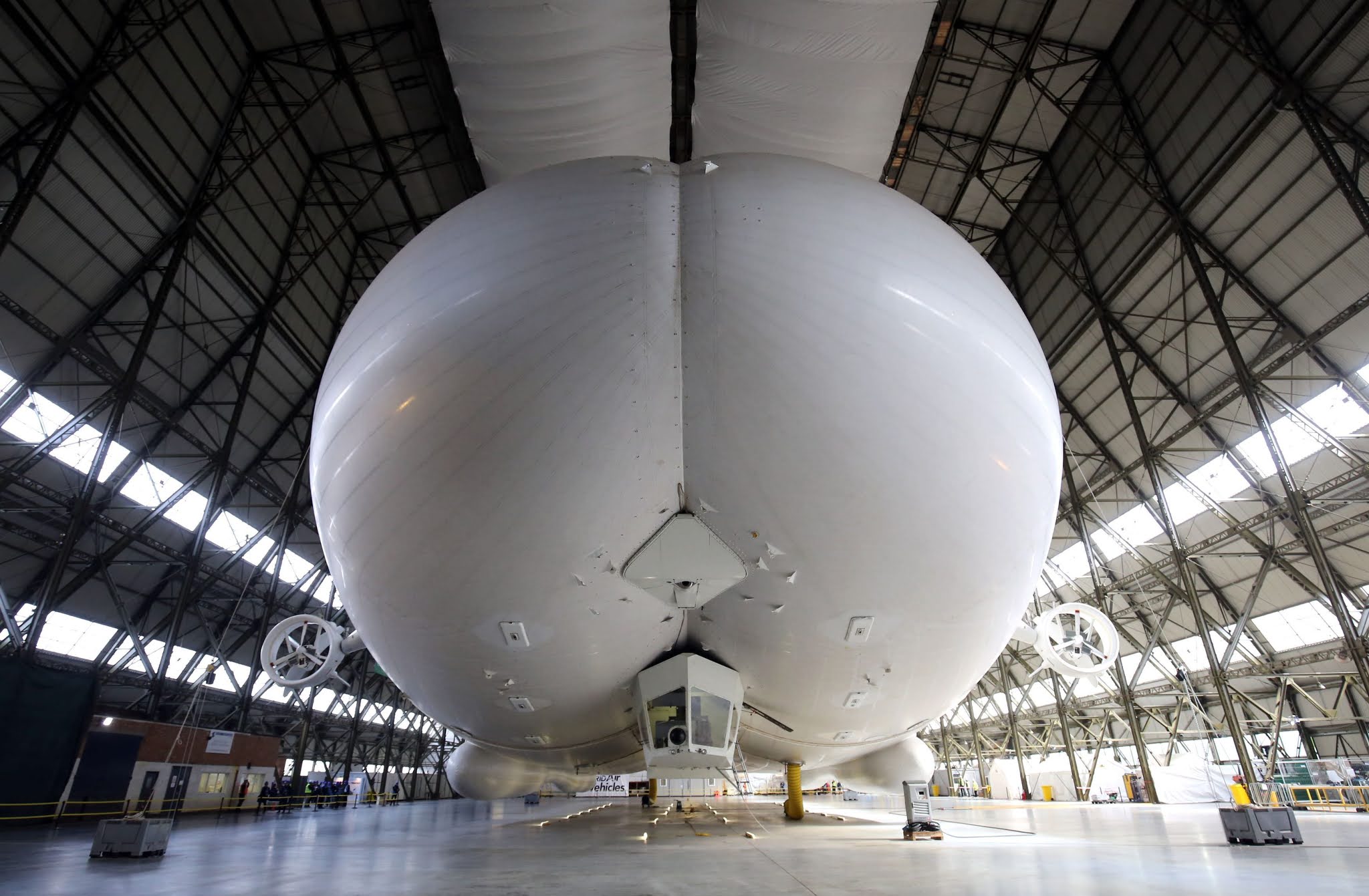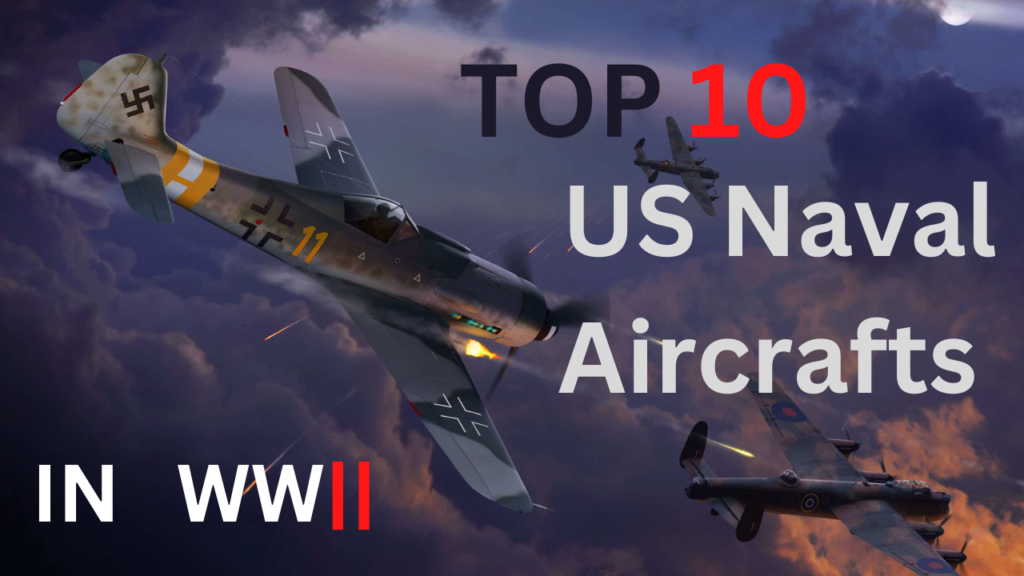
A number of the world’s most recognizable planes first saw service during times of conflict, which may be directly attributed to that environment of rapid technological advancement. The development of passenger jet aircraft in the decades after World War II would have been hindered without these wars, which in turn would have been detrimental to the security of the world.
However, the US aircraft industry was dedicated to unwavering technical dominance in warfare, and as a result, it often went beyond the bounds of what was thought to be achievable. The purpose of compiling this index of the finest US Naval aircraft of the era is to shed insight into the design and performance of these remarkable planes.
So let’s take a look at the top ten WWII US Naval aircraft –
Grumman F4F Wildcat
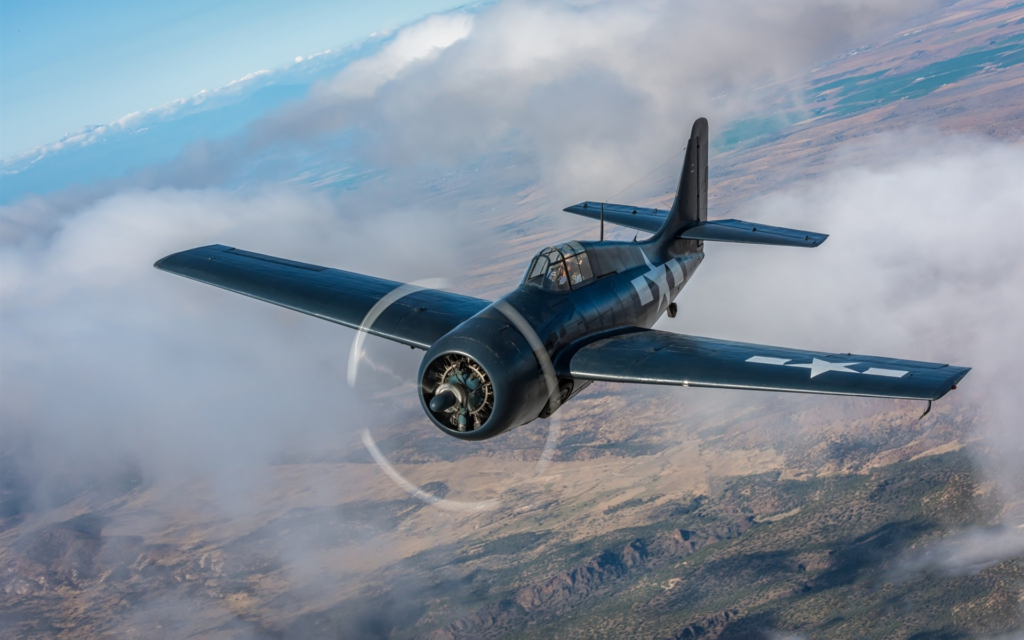
American carrier-based fighter aircraft, the Grumman F4F Wildcat, first saw service in 1940 with the British Royal Navy and the United States Navy, where it was first known as the Martlet. The Wildcat was the sole efficient fighter available to the United States Navy and Marine Corps in the Pacific Theater during the early stages of the Second World War, having first been employed by the British in the North Atlantic.
The Wildcat’s subpar performance against the Zero in the engagements of the Coral Sea and Midway profoundly disappointed US Navy pilots, especially John “Jimmy” Thach, a pioneer of fighter tactics to deal with the A6M Zero. According to claims, the Wildcat had an air combat kill-to-loss ratio of 5.9:1 in 1942 and 6.9:1 throughout the conflict.
Later, the quicker F6F Hellcat was developed using the knowledge gained from the slower Wildcat. While the Hellcat could rely on a higher power and high-speed capabilities to outperform the Zero, the Wildcat had better range and maneuverability at low speeds. The larger and heavier Hellcat could not be employed on escort carriers, so the Wildcat was built and maintained throughout the rest of the war.
Specifications and dimensions
| Specs | Grumman F4F Wildcat |
| Length: | 28 ft 9 in (8.76 m) |
| Wingspan: | 38 ft (11.58 m) |
| Height: | 11 ft 10 in (3.61 m) |
| Empty Weight: | 4,907 lb (2,226 kg) |
| Engine: | 1 × Pratt & Whitney R-1830-76 |
| Max speed: | 331 mph (533 kph) |
| Range: | 845 mi (1,360 km) |
| Ceiling: | 39,500 ft (12,000 m) |
Grumman F6F Hellcat
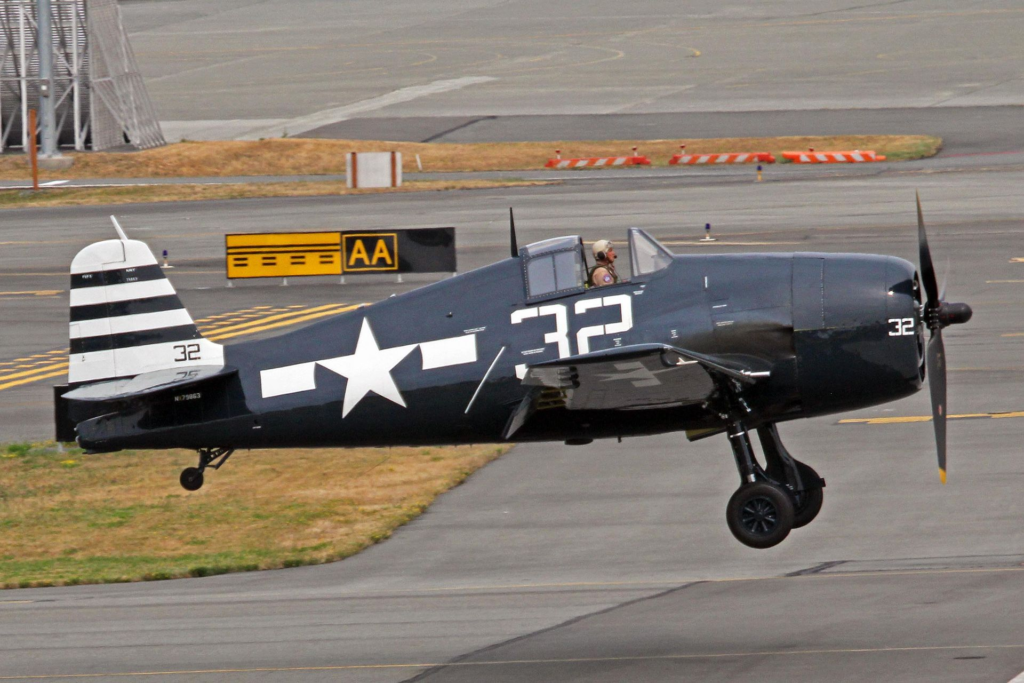
Developed to replace the earlier F4F Wildcat and to compete with the Japanese Mitsubishi A6M Zero, the Grumman F6F Hellcat is an American carrier-based fighter aircraft from World War II. During the second half of the Pacific War, it dominated the competition. To land that job, it beat out the faster Vought F4U Corsair, which had issues with visibility and carrier landings. The Hellcat has been referred to as “the Wildcat’s larger brother” by some military experts.
The F6F, which made its combat debut in September 1943, is most remembered for its ability to outperform the A6M Zero and contribute to the establishment of air superiority over the Pacific theatre. It was a tough, well-designed carrier fighter. In slightly over two years, 12,275 buildings were erected altogether.
While in U.S. service, Hellcats are credited with downing 5,223 enemy aircraft in total for the Navy, U.S. Marine Corps, and Fleet Air Arm of the Royal Navy (FAA)—more than any other Allied naval aircraft, in fact. After the war, Hellcats were gradually phased out of front-line service in the US, but F6F-5Ns with radar were still in use as night fighters in 1954.
Specifications and dimensions
| Specs | Grumman F6F Hellcat |
| Length: | 33 ft 7 in (10.24 m) |
| Wingspan: | 42 ft 10 in (13.06 m) |
| Height: | 13 ft 1 in (3.99 m) |
| Empty Weight: | 9,238 lb (4,190 kg) |
| Engine: | 1 × Pratt & Whitney R-2800-10W Double Wasp |
| Max speed: | 391 mph (629 kph) |
| Range: | 945 mi (1,521 km) |
| Ceiling: | 37,300 ft (11,400 m) |
Grumman TBF Avenger
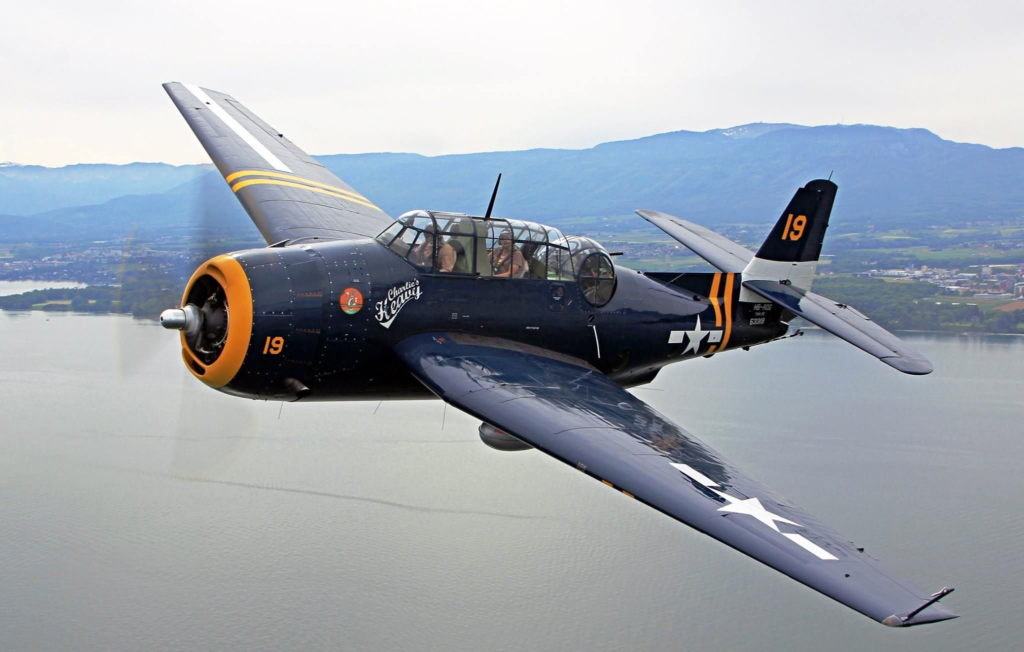
The Grumman TBF Avenger is a torpedo bomber from World War II that was built in the United States initially for the US Navy and Marine Corps and afterward deployed by several air and naval aviation services all over the world.
The United States initially used the Avenger in 1942 during the Battle of Midway. It survived in service to become the most effective and commonly deployed torpedo bomber of World War II, sharing credit for sinking the super-battleships Yamato and Musashi and being credited for sinking 30 submarines, despite losing five of the six Avengers during its combat debut. It was heavily upgraded after the war and used up to the 1960s.
Specifications and dimensions
| Specs | Grumman TBF Avenger |
| Length: | 40 ft (12.195 m) |
| Wingspan: | 54 ft 2 in (16.51 m) |
| Height: | 16 ft 5 in (5.00 m) |
| Empty Weight: | 10,080 lb (4572 kg) |
| Engine: | 1 × Wright R-2600-8 Twin Cyclone |
| Max speed: | 278 mph (447 kph) |
| Range: | 905 mi (1,456 km) |
| Ceiling: | 22,600 ft (6,900 m) |
Consolidated PB4Y-2

The Consolidated PB4Y-2 Privateer is a United States Navy patrol bomber from World War II and the Korean War that evolved from the Consolidated B-24 Liberator. The PB4Y-1 Liberator, which was developed by the Navy using B-24s with just minimal modifications, along with the maritime patrol Liberators deployed by RAF Coastal Command, were successful patrol aircraft.
Consolidated created the PB4Y-2 Privateer long-range patrol bomber in 1943 in response to the demand for a completely navalized design. The type was given the new designation P4Y-2 Privateer in 1951. The remaining Navy Privateers underwent another reclassification in September 1962 when they were given the new designation QP-4B.
Specifications and dimensions
| Specs | Consolidated PB4Y-2 |
| Length: | 74 ft 7 in (22.73 m) |
| Wingspan: | 110 ft 0 in (33.53 m) |
| Height: | 30 ft 1 in (9.17 m) |
| Empty Weight: | 27,485 lb (12,467 kg) |
| Engine: | 4 × Pratt & Whitney R-1830-94 radial engines |
| Max speed: | 300 mph (482 kph) |
| Range: | 2,820 mi (4,540 km) |
| Ceiling: | 21,000 ft (6,400 m) |
Consolidated PBY Catalina
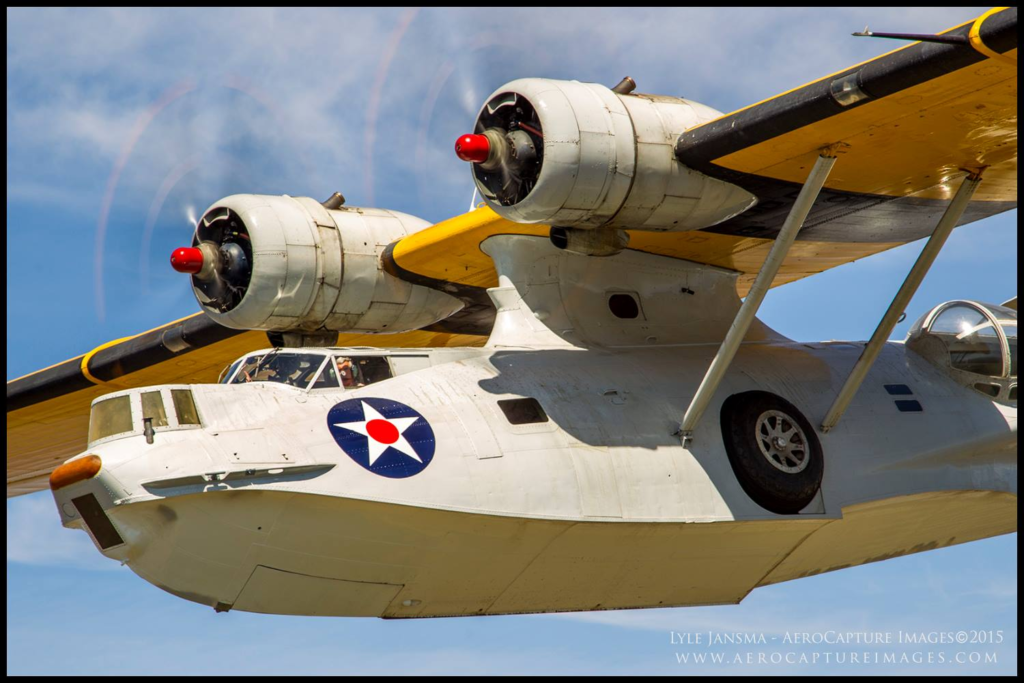
In the 1930s and 1940s, Consolidated produced the PBY Catalina, a flying boat and amphibious aircraft. Its name in Canadian service was the Canso. Catalinas served with every branch of the United States Armed Forces as well as in the air forces and navies of many other countries, making it one of the most widely used seaplanes of World War II.
The 1980s saw the last of the military’s PBYs in service. The aircraft is still in use as a waterbomber (or airtanker) in some regions of the world as of 2022, 87 years after its initial flight. None are still in the military.
Specifications and dimensions
| Specs | Consolidated PBY Catalina |
| Length: | 63 ft 10.875 in (19.47863 m) |
| Wingspan: | 104 ft (32 m) |
| Height: | 21 ft 1 in (6.43 m) |
| Empty Weight: | 20,910 lb (9,485 kg) |
| Engine: | 2 × Pratt & Whitney R-1830-92 Twin Wasp |
| Max speed: | 196 mph (315 kph) |
| Range: | 2,520 mi (4,060 km) |
| Ceiling: | 15,800 ft (4,800 m) |
Curtiss SBC Helldiver

The Curtiss-Wright Corporation produced the two-seat scout bomber known as the Curtiss SBC Helldiver. It was the final military biplane the US Navy purchased. It was delivered in 1937, but it was kept far from Axis fighter combat because it was rendered obsolete even before the start of World War II.
Midway through 1937, the Navy began receiving the new aircraft, with the first batch of carrier-based aircraft going to Yorktown. However, as time and technology progressed, the sophisticated biplane fell behind. It was restricted to hacking responsibilities and used as an advanced trainer for Florida training units. In October 1944, the last aircraft was removed from the Navy’s inventory.
The SBC Helldiver was not intended to serve the United States for a long time, but it still had an impact because it was a key platform for the development of dive-bombing strategies and the improvement of aircrew abilities essential to winning the Pacific War.
Specifications and dimensions
| Specs | Curtiss SBC Helldiver |
| Length: | 28 ft 1 in (8.574 m) |
| Wingspan: | 34 ft (10.36 m) |
| Height: | 10 ft 5 in (3.18 m) |
| Empty Weight: | 4,552 lb (2,065 kg) |
| Engine: | 1 × Wright R-1820-34 radial engine |
| Max speed: | 234 mph (377 kph) |
| Range: | 405 mi (652 km) |
| Ceiling: | 24,000 ft (7,300 m) |
Curtiss SB2C Helldiver
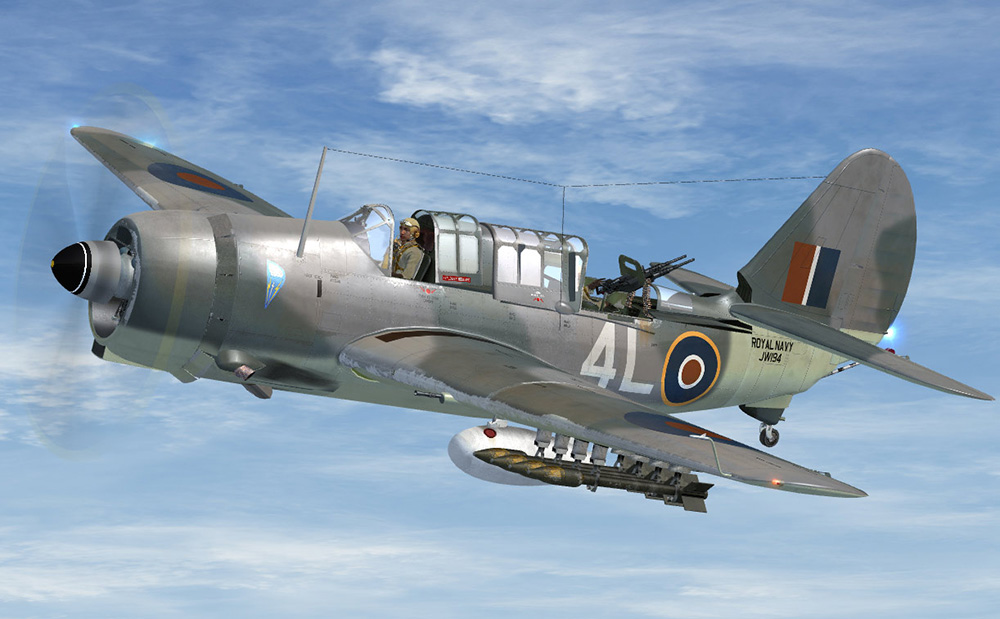
In the course of World War II, Curtiss-Wright created the dive bomber known as the Curtiss SB2C Helldiver, also referred to as the A-25 Shrike. It augmented and replaced the Douglas SBD Dauntless as the US Navy’s carrier-based bomber in the Pacific. Only a few survivors remain.
Poor handling qualities and late revisions initially led to significant production and deployment delays, to the point where the Truman Committee looked into it and produced a damning report. This hastened the demise of Curtiss as a business. However, the type was quicker than the Dauntless, and by the end of the Pacific War, USN ships mostly used the Helldiver as their dive bomber and attack aircraft.
The Western Allied air forces had given up specialist dive-bombers by the time the land-based A-25 Shrike became available in late 1943. Most of the A-25 aircraft that were delivered to the US Army Air Forces were transferred to the US Marine Corps, which only utilized the type in non-combat and one-sided campaign missions.
The aircraft was also known by the nicknames “Big-Tailed Beast” or simply “Beast,” “Two-Cee,” and “Son-of-a-Bitch 2nd Class,” the latter of which was based on the aircraft’s designation SB2C and its reputation for having challenging handling qualities.
Specifications and dimensions
| Specs | Curtiss SB2C Helldiver |
| Length: | 36 ft 8 in (11.18 m) |
| Wingspan: | 49 ft 9 in (15.16 m) |
| Height: | 13 ft 2 in (4.01 m) |
| Empty Weight: | 10,547 lb (4,784 kg) |
| Engine: | 1 × Wright R-2600-20 Twin Cyclone |
| Max speed: | 295 mph (475 kph) |
| Range: | 1,165 mi (1,875 km) |
| Ceiling: | 29,100 ft (8,900 m) |
Vought F4U Corsair

American fighter planes used in World War II and the Korean War principally included the Vought F4U Corsair. Chance Vought created and first produced the Corsair, which became quite popular very quickly.
The Corsair entered service with the U.S. Navy in large numbers in late 1944 and early 1945. It was built and used as a carrier-based aircraft. It swiftly rose to become one of World War II’s most effective carrier-based fighter bombers. Its naval aviators recorded an 11:1 kill ratio, and some Japanese pilots considered it to be the most fearsome American fighter of World War II. Early logistical and carrier landing issues caused it to lose its position as the primary carrier-based fighter to the Grumman F6F Hellcat.
The Korean War and the French colonial wars in Indochina and Algeria saw Corsair almost entirely in combat as a fighter bomber. The Corsair was utilized by the Royal New Zealand Air Force, French Naval Aviation, and other air forces until the 1960s, in addition to the U.S. and British.
12,571 F4U Corsairs in 16 different models were produced between the 1940 delivery of the first prototype to the American Navy and the 1953 delivery of the last one to the French. The longest production run of any American piston-engined fighter was from 1942 to 1953.
Specifications and dimensions
| Specs | Vought F4U Corsair |
| Length: | 33 ft 8 in (10.26 m) |
| Wingspan: | 41 ft (12.50 m) |
| Height: | 14 ft 9 in (4.50 m) |
| Empty Weight: | 9,205 lb (4,238 kg) |
| Engine: | 1 × Pratt & Whitney R-2800-18W radial engine |
| Max speed: | 446 mph (717 kph) |
| Range: | 1,005 mi (1,617 km) |
| Ceiling: | 41,500 ft (12,600 m) |
Douglas SBD Dauntless

A dive bomber and World War II naval scout plane, the Douglas SBD Dauntless was produced by Douglas Aircraft between 1940 and 1944. From the middle of 1940 through the middle of 1944, the SBD, short for “Scout Bomber Douglas,” served as the primary carrier-based scout/dive bomber for the US Navy.
The US Marine Corps also used land-based air bases and aircraft carriers to fly the SBD. The SBD is most known for being the bomber that struck the Japanese carriers to death at the Battle of Midway in June 1942. During this time, the type acquired the moniker “Slow But Deadly” (derived from its SBD initials).
The SBD excelled as a dive bomber and naval scout plane during its combat career. Long range, good handling, maneuverability, a powerful bomb load, great diving characteristics thanks to the perforated dive brakes, good defensive armament, and toughness were all features it possessed. The A-24 Banshee, a land-based version of the SBD without the arrestor hook, was created especially for the U.S. Army Air Forces.
Specifications and dimensions
| Specs | Douglas SBD Dauntless |
| Length: | 33 ft 1.25 in (10.0902 m) |
| Wingspan: | 41 ft 6.375 in (12.65873 m) |
| Height: | 13 ft 7 in (4.14 m) |
| Empty Weight: | 6,404 lb (2,905 kg) |
| Engine: | 3-bladed Hamilton-Standard constant-speed |
| Max speed: | 255 mph (410 kph) |
| Range: | 1,115 mi (1,794 km) |
| Ceiling: | 25,530 ft (7,780 m) |
Douglas TBD Devastator
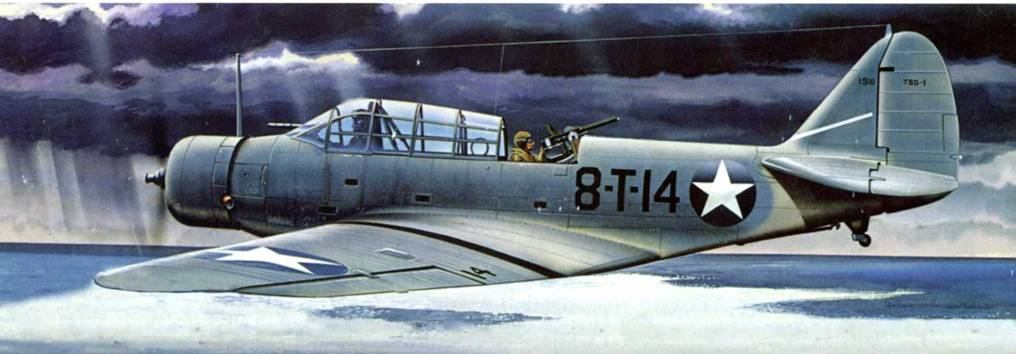
The United States Navy’s Douglas TBD Devastator was a torpedo bomber. It was first flown in 1935, after which it entered service in 1937. It was the Navy’s and arguably any navy’s flying fleet’s most technologically advanced aircraft at the time. However, the rapid advancement of aircraft soon overtook it, and by the time of the Japanese attack on Pearl Harbor, the TBD had become obsolete.
Early battles saw the Devastator perform admirably, most notably in the Battle of Coral Sea. However, the Devastator gained notoriety for a disastrous performance at the Battle of Midway, where 41 of the ships recorded zero torpedo hits, and only six managed to return to their carriers.
The majority of the force was destroyed with little consequence other than to divert the Mitsubishi Zero fighters from the SBD Dauntless dive bombers that sank four carriers and a heavy cruiser. These fighters were vastly superior to them in terms of speed and maneuverability.
The Devastator was replaced by the Grumman TBF Avenger after Midway, despite the fact that much of its poor performance was later attributed to the US Mark 13 torpedo’s numerous, well-documented flaws.
Specifications and dimensions
| Specs | Douglas TBD Devastator |
| Length: | 35 ft (10.67 m) |
| Wingspan: | 50 ft (15.24 m) |
| Height: | 15 ft 1 in (4.60 m) |
| Empty Weight: | 5,600 lb (2,540 kg) |
| Engine: | 1 × Pratt & Whitney R-1830-64 Twin Wasp |
| Max speed: | 206 mph (332 kph) |
| Range: | 435 mi (700 km) |
| Ceiling: | 19,500 ft (5,900 m) |
Ending Notes
With this, we end our list right here. Many of these aircraft have a legacy of war and pushing military development to new standards. These planes suitably reflect the history of World War 2, making the US involvement noteworthy, and we felt excited to draft them in front of you.


